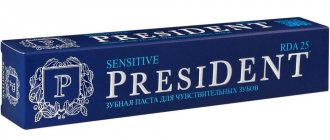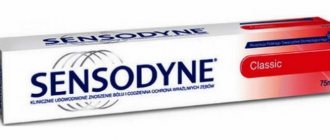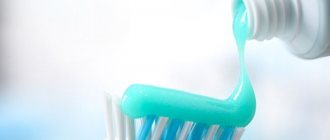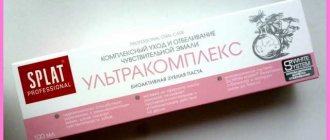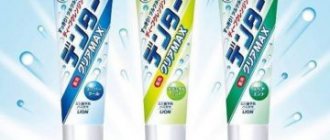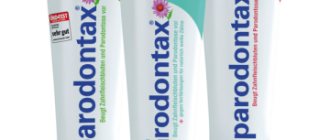From this article you will learn:
- causes of hypersensitivity of human teeth,
- best toothpaste for sensitive teeth,
- analysis of paste compositions, rating 2022.
Toothpaste can act not only as a means for cleaning teeth, but also, thanks to the inclusion of a number of active ingredients, help reduce tooth hypersensitivity, relieve inflammation in the gums, and also help strengthen tooth enamel. With increased tooth sensitivity, pain usually occurs in response to thermal and mechanical stimuli - cold, hot, when touching the teeth with a toothbrush, and sometimes even from sweets.
In most cases, this problem can be solved at home, using special toothpastes for sensitive teeth, as well as by applying gels containing one of the fluoride compounds to the necks of teeth. Pastes and gels from different manufacturers, due to their different compositions, differ in their effectiveness, and in this article we will analyze the composition of the most popular products for relieving hypersensitivity of tooth enamel.
Causes of hypersensitivity development –
First of all, this problem is associated with the thinning of the enamel layer in the area of the necks of the teeth, or with the exposure of the roots of the teeth and the thinning of the “cement” layer located on their surface.
As a result, a deeper layer of tooth tissue is exposed - dentin, which is located immediately under the enamel and cement. Dentin microscopically consists of dentinal tubes in which fluid circulates. If the dentin is not covered with enamel and cement on top, then thermal and other irritants can sharply increase the speed of fluid flow through the dentinal tubules, which ultimately leads to irritation of the nerve endings in the dental pulp and the occurrence of pain. The trigger for the development of pain (in the presence of dentin exposure) can be the consumption of acidic foods and drinks, the use of whitening toothpastes, etc.
Sensitive teeth: how to choose a toothpaste?
Dental problems can cause discomfort for anyone. There is hardly a person who was not afraid of the dentist as a child. One of the unpleasant manifestations may be increased sensitivity.
What is hypersensitivity
Any person can experience increased sensitivity of enamel for a short time. It’s worse when this condition takes a permanent form and prevents you from enjoying delicious dishes, drinks, or leads to a fear of opening your mouth on a frosty walk, since cold air touching your teeth leads to pain.
More precisely, sensitivity increases due to thinning of the enamel. Then it is easier for any external influences to reach the nerve inside the tooth through thin tubes that penetrate the hard tissue. Normally, a sufficient layer of enamel covers the dentin and reliably protects the nerve endings from any external irritants.
Symptoms
Unpleasant sensations and pain are caused by something that was not paid any attention to before:
- Cold drinks
- Hot tea
- Candies
- Teeth cleaning
- Any acidic drinks (juices, soda)
- Touching teeth
Sometimes these symptoms can occur with caries, periodontal disease, and enamel defects after chipping. But it also happens that the teeth seem to be absolutely healthy, but there is a problem.
The cause of increased sensitivity can be completely different actions
Causes
The cause of increased sensitivity can be completely different actions, but they are united by one excessive effect of acid on the enamel:
- Frequent use of mouthwash. They often contain acids.
- Recent bleaching. If the dentist did it, then it was done carefully and they gave you clear recommendations on what is possible and what is not. Worse. if you carried out whitening procedures at home yourself, you used strong products and could damage the enamel surface.
- There are problems with the gums from smoking, lack of professional hygiene, the formation of tartar and, as a result, exposure of the roots.
- You damage your enamel by gnawing on seeds, nuts, or other hard foods or objects.
- Rejection of stomach contents into the mouth. The so-called esophageal reflux disease, when the sphincter of the entrance to the esophagus closes weakly for some reason and when bending forward, physical activity, or in the evening before bed, acidic contents from the stomach are refluxed.
- Frequent consumption of acidic drinks during the day.
It can also be a symptom of other problems in the body.
What to do
If you know what could have caused the increase in sensitivity, rule out the effect of this factor. Also avoid anything that can negatively affect the enamel. Put off whitening, use toothpastes with a minimal abrasive effect, and a toothbrush with soft bristles.
A large number of toothpastes have been developed for sensitive teeth that can help cope with this problem.
- Hilfen Toothpaste Sensitive formula
- Colgate Sensitive Pro-Relief
- PresiDent Sensitive
- Lacalut Extra Sensitive
- Elmex Sensitive plus
- Asepta Sensitive
- Lacalut Sensitive
- Hilfen Toothpaste Sensitive formula
- Splat Professional Sensitive
Price categories and manufacturers can vary greatly. But there are several general important points that help achieve the desired effect of reducing sensitivity.
- Features of toothpaste for sensitive teeth:
- They have a low RDA. He talks about particle size. For the most gentle pastes, it can be less than 15. The lower the number, the smaller the particles contained in the paste and the more gentle they are on the enamel.
- Almost all contain calcium hydroxyapatite. It helps in remineralizing the enamel and restoring the barrier against external irritants.
- Fluorine can be contained in high concentrations or absent altogether. There is no consensus on the benefits or harms of fluoride. The peculiarity of many regions of Russia is that they are endemic areas for fluoride deficiency and the risk of developing fluorosis, which everyone is afraid of, is practically absent.
- Medicinal soothing herbs, extracts. They have a greater effect on the condition of the gums than on the enamel itself. It will be important for periodontal disease and bleeding gums.
If sensitivity continues to bother you, you should contact your dentist. The doctor may recommend specialized highly concentrated remineralizing gels for a course of treatment:
- ROCS Medical Minerals Remineralizing gel
- ROCS Medical Minerals Remineralizing gel for children Strawberry
Also, in a dental office, it is possible to apply protective coatings to the surface of teeth to reduce sensitivity.
How to choose a toothpaste for sensitive teeth -
Toothpastes for relieving tooth sensitivity (hypersthesia) have specific characteristics. Firstly, toothpaste for sensitive teeth usually has a fairly low abrasiveness within the RDA range of 25 to 35 (RDA - abrasiveness index). For example, for ordinary therapeutic and prophylactic toothpastes the RDA index is 75, and for whitening pastes it is usually 100-120.
The second important point to pay attention to is the active components. Different manufacturers use ingredients that are different from each other, which have different mechanisms for reducing tooth sensitivity, and as a result, have different effectiveness and different speed of onset of effect. Based on the mechanism of action, the following groups of components can be distinguished...
Active components in toothpastes for sensitive teeth -
- Potassium nitrate, potassium chloride - these components block the transmission of nerve impulses.
The transmission of nerve impulses is based on the exchange of potassium ions (located inside nerve cells) with sodium ions located outside the nerve. By increasing the concentration of potassium ions around the nerve endings, we disrupt this exchange, which leads to the absence of pain in the teeth - in response to thermal and mechanical stimuli. The advantage of these components is that the effect of their use develops very quickly. However, the result will last as long as you use them. Thus, potassium nitrate and chloride can quickly relieve pain, but they do not eliminate the very cause of hyperesthesia.
- Fluorides, strontium chloride, zinc citrate, hydroxyapatite - these components affect precisely the cause of the development of dental hypersensitivity - the accelerated movement of fluid in the dentinal tubules, which leads to irritation of the nerve endings.
Fluoride compounds (sodium fluoride, aminofluoride, monofluorophosphate), strontium chloride, zinc citrate, hydroxyapatite - all of them clog the dentinal tubules, preventing the movement of fluid in them. In addition, strontium chloride also promotes the deposition of replacement dentin and the compaction of its structure, which also helps reduce hypersensitivity. However, the downside of all these components is that the effect from their use develops more slowly than from the use of potassium nitrate or potassium chloride.
- Arginine and calcium carbonate combination - a combination of Arginine (an amino acid) and calcium carbonate in toothpaste - is also very effective in treating dental hypersensitivity.
Arginine facilitates the deposition of a layer of calcium carbonate on the surface of the teeth, which in turn stimulates the deposition of phosphates on the surface of exposed dentin and in the dentinal tubules, contributing to their clogging and reducing the movement of fluid in them. However, although it reduces sensitivity well, it does not solve the problem of demineralization of enamel and dentin. It should be noted here that the layer of calcium carbonate with arginine will be inactive, and calcium from this layer will not penetrate into the hard tissues of the teeth. This distinguishes arginine carbonate pastes from pastes with fluorides, after the use of which an active layer of calcium fluoride (CaF2) is created on the tooth surface. In addition to the fact that CaF2 also clogs the dentinal tubules on the surface of exposed dentin, calcium and fluoride from this layer are able to penetrate into the hard tissues of the teeth, strengthening them.
Conclusions -
Precisely because some components are capable of providing an immediate effect, while others (although their effect develops slowly, they eliminate precisely the cause of pain) - most toothpastes for sensitivity are made with a combined composition. Where potassium nitrate quickly relieves pain, and fluorides, hydroxyapatite, strontium chloride, or a combination of arginine and calcium carbonate clog exposed dentinal tubules.
However, there are also effective monocomponent products for use at home. Such products contain a very high concentration, usually of only one component, for example, potassium nitrate or sodium fluoride. In this way, they resemble professional means for reducing sensitivity that dentists use in their work. Examples of such gels are PRESIDENT Sensitive Plus and Colgate® Duraphat. How they can help you - read below.
Review of the best toothpastes
Toothpaste must be chosen not only based on advertising and cost, but also on the components of the composition. The safety of your teeth and gums depends on it.
- LACALUT Extra Sensitive.
This pasta takes an honorable first place and there is an explanation for this. It is of German production and quality. It contains beneficial active ingredients. They strengthen tooth enamel and reduce sensitivity. Pain sensations are reduced.
- PRESIDENT Sensitive.
This pasta is made by an Italian company. It contains less fluoride. However, it is also effective and in good standing. Its active components are the necessary substances. Potassium nitrate affects nerve endings, thereby reducing their sensitivity and reducing negative sensations. Sodium fluoride helps strengthen enamel. Hydroxyapatite nourishes the enamel with calcium and activates its resistance to temperature. A low level of abrasiveness allows you to efficiently remove plaque without damaging the enamel.
- SENSODYNE F.
This is an English-made paste in which the active ingredients are sodium fluoride and zinc. It has a healing effect and restores damaged enamel, reduces the sensitivity threshold. This is an excellent option for an inexpensive but effective paste. Of course, the effect will be smaller than the leaders, but nevertheless it will be there.
- SILCA Complete Sensitive.
This is a budget option when dealing with sensitivity. Contains medicinal substances. They block calcium leaching and neutralize acids. With constant use, the level of hyperesthesia decreases.
Toothbrushes for sensitive teeth –
In cases where the touch of the toothbrush bristles to the necks of the teeth causes pain and discomfort, it is recommended to use special toothbrushes with soft bristles when brushing your teeth. These brushes are marked “Soft”. They also differ from ordinary toothbrushes in that each bristle has a rounded or very thin atraumatic tip.
Price for toothbrushes for sensitive teeth –
- SENSODYNE Sensitive toothbrush – from 160 rubles,
- LACALUT Sensitive toothbrush – from 190 rubles.
Important: use this brush only in cases where pain occurs when touching your teeth with a regular toothbrush. They cannot be used on an ongoing basis, because... Brushes with soft bristles remove microbial plaque from teeth much worse than brushes with medium hardness, and therefore, with prolonged use, plaque and tartar may accumulate on the teeth.
Causes of the problem:
- Violation of the integrity of tooth enamel during chemical whitening;
- Frequent consumption of acidic foods;
- Lack of vitamins, minerals and trace elements in the body;
- Inflammatory process of the gums;
- Tartar removal;
- Erasure of enamel;
- Grinding the tooth for crown installation;
- Inflammatory process in the oral cavity;
- Eating hot foods together with cold ones;
- Malocclusion;
- Poor oral hygiene;
- Unbalanced diet;
- Smoking.
Buy Sensodyne toothpaste Restoration and Protection of whiteness. 75ml in pharmacies
Sensodyne is the #1 recommended* brand by dentists for sensitive teeth. Exposed dentin causes increased tooth sensitivity. With Sensodyne Restoration and Protection Whitening toothpaste you have the opportunity to restore normal sensitivity. Sensodyne Restoration and Protection Whitening toothpaste forms a protective layer on the surface of sensitive areas of the teeth, similar in composition to natural tooth enamel. Use Sensodyne Restoration and Protection Whitening Paste 2 times a day to restore and protect teeth from sensitivity. At the same time, Sensodyne Restoration and Protection Whitening paste helps maintain the natural whiteness of teeth**.
* “Study of recommendations by dentists of various brands in the oral care segment”, Institute of Marketing Research GFK-Rus, November 2022 – January 2022.
** When brushing daily 2 times a day
Compound:
Glycerin, PEG-8, Hydrated Silica, Calcium Sodium Phosposilicate, (NOVAMIN), Cocamidopropyl Betaine, Sodium Methyl Cocoyl Taurate, Titanium Dioxide, Aroma, Carbomer, Sodium Fluoride, Sodium Saccharin, Limonene. Mass fraction of fluoride 0.145% F"" (1450 ppm). Contains sodium fluoride.
pharmachologic effect
Exposed dentin causes increased tooth sensitivity. With Sensodyne Restoration and Protection Whitening toothpaste you have the opportunity to restore normal sensitivity.
Sensodyne Restoration and Protection Whitening toothpaste forms a protective layer on the surface of sensitive areas of the teeth, similar in composition to natural tooth enamel. Use Sensodyne Restoration and Protection Whitening Paste 2 times a day to restore and protect teeth from sensitivity. At the same time, Sensodyne Restoration and Protection Whitening paste helps maintain the natural whiteness of teeth.
Indications for use
Daily dental and oral care.
Contraindications
Individual intolerance to components.
Carefully
If irritation occurs during use of the product, use of the paste should be discontinued.
Stop using the product and contact your dentist if:
Tooth sensitivity persists or worsens. Sensitive teeth may be a sign of a serious medical condition that requires immediate treatment from a dentist.
Tooth pain/sensitivity persists after 4 weeks of using the product.
Use during pregnancy and lactation
There are no contraindications to the use of toothpaste during pregnancy and lactation.
Directions for use and doses
Apply a pea-sized amount of toothpaste to a soft-bristled toothbrush.
Brush your teeth twice a day for 1 minute, but no more than three times, or as recommended by your dentist (attending physician). Try to brush all sensitive areas of your teeth more thoroughly. Do not swallow. Spit.
Side effect
Allergic reactions.
Release form
Paste in a tube of 75 ml, 1 tube in a cardboard package.
Storage conditions
Store in a dry place, out of reach of children, at a temperature not exceeding 30°C.
Best before date
2 years. Do not use after the expiration date.
Manufacturer
The pharmaceutical company GlaxoSmithKline is one of the world's largest manufacturers of over-the-counter oral health products. Under her leadership, products of such well-known brands as Sensodyne, Parodontax, Corega, and Aquafresh are produced.
The main facilities of this giant are located in the UK, Ireland, Singapore, Spain and the USA. Research work is carried out in 20 laboratories equipped with modern equipment, under the guidance of highly qualified specialists.
The Sensodyne brand, known in most European countries, including Russia, develops and produces toothpastes designed specifically to combat tooth sensitivity, gum inflammation and plaque on enamel.

